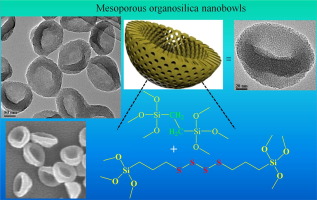Journal of Colloid and Interface Science ( IF 9.4 ) Pub Date : 2018-05-30 , DOI: 10.1016/j.jcis.2018.05.104 Xin Du , Weike Li , Bingyang Shi , Luying Su , Xiaoyu Li , Hongwei Huang , Yongqiang Wen , Xueji Zhang

|
Mesoporous organosilica materials with organo-bridged silsesquioxane and novel structures have attracted great attention due to combined or enhanced properties. Here, we achieved facile synthesis of uniform well-defined mesoporous organosilica nanobowls with ethane- or ethane&thioether-bridged silsesquioxane framework by one-pot reaction. The possible formation mechanism may be attributed to be a dynamic growth, dissolution and reassembly process, including a uniform coating of ethane-bridged organosilica on the surface of mesoporous silica nanoparticles (MSNs) or mesoporous organosilica nanoparticles (MONs), gradual dissolution of MSNs or MONs core for the collapse of hollow spheres, and regrowth and reassembly of a small portion of the dissolved species. The framework stability of MSNs can be regulated by adjusting the amount of introduction of thioether-bridged silsesquioxane in the framework from 0 to 100%, which determines the structures of finally obtained products (nanobowls or rough nanoparticle (NPs)). The interesting results shed light on fundamental mechanisms of growth and dissolution for design and synthesis of novel structured materials. The ethane&thioether-bridged nanobowls show good hemocompatibility and low cytotoxicity compared with ethane-bridged nanobowls and calcined MCM-41-typed MSNs. The unique nanobowl structure, worm-like mesochannels and silsesquioxane framework make it as potential candidates for nanobiomedical applications.
中文翻译:

通过一锅生长和溶解机理轻松合成具有桥连倍半硅氧烷骨架的介孔有机硅纳米碗
具有有机桥联倍半硅氧烷和新颖结构的介孔有机二氧化硅材料因其综合或增强的性能而备受关注。在这里,我们通过一锅法反应轻松地合成了具有乙烷或乙烷与硫醚桥联倍半硅氧烷框架的均一的定义明确的介孔有机二氧化硅纳米碗。可能的形成机理可归因于动态生长,溶解和重新组装过程,包括在介孔二氧化硅纳米颗粒(MSN)或介孔有机二氧化硅纳米颗粒(MONs)的表面上均匀覆盖乙烷桥联有机二氧化硅,逐步溶解MSN或MONs的核心是空心球的塌陷,以及一小部分溶解物质的再生和重新组装。MSN的骨架稳定性可以通过将骨架中硫醚桥连倍半硅氧烷的引入量从0%调整为100%,从而确定最终获得的产品(纳米碗或粗纳米颗粒(NPs))的结构。有趣的结果阐明了新颖结构材料的设计和合成的生长和溶解的基本机理。与乙烷桥联的纳米杯和煅烧的MCM-41型MSN相比,乙烷桥联和硫醚桥联的纳米杯具有良好的血液相容性和低细胞毒性。独特的纳米碗结构,蠕虫状的介导通道和倍半硅氧烷框架使其成为纳米生物医学应用的潜在候选者。它决定了最终获得的产品(纳米碗或粗糙的纳米颗粒(NPs))的结构。有趣的结果阐明了新颖结构材料的设计和合成的生长和溶解的基本机理。与乙烷桥联的纳米杯和煅烧的MCM-41型MSN相比,乙烷桥联和硫醚桥联的纳米杯具有良好的血液相容性和低细胞毒性。独特的纳米碗结构,蠕虫状的介导通道和倍半硅氧烷框架使其成为纳米生物医学应用的潜在候选者。它决定了最终获得的产品(纳米碗或粗糙的纳米颗粒(NPs))的结构。有趣的结果阐明了新颖结构材料的设计和合成的生长和溶解的基本机理。与乙烷桥联的纳米杯和煅烧的MCM-41型MSN相比,乙烷桥联和硫醚桥联的纳米杯具有良好的血液相容性和低细胞毒性。独特的纳米碗结构,蠕虫状的介导通道和倍半硅氧烷框架使其成为纳米生物医学应用的潜在候选者。与乙烷桥联的纳米碗和煅烧的MCM-41型MSN相比,硫醚桥联的纳米碗显示出良好的血液相容性和低细胞毒性。独特的纳米碗结构,蠕虫状的介导通道和倍半硅氧烷框架使其成为纳米生物医学应用的潜在候选者。与乙烷桥联的纳米碗和煅烧的MCM-41型MSN相比,硫醚桥联的纳米碗显示出良好的血液相容性和低细胞毒性。独特的纳米碗结构,蠕虫状的介导通道和倍半硅氧烷框架使其成为纳米生物医学应用的潜在候选者。











































 京公网安备 11010802027423号
京公网安备 11010802027423号